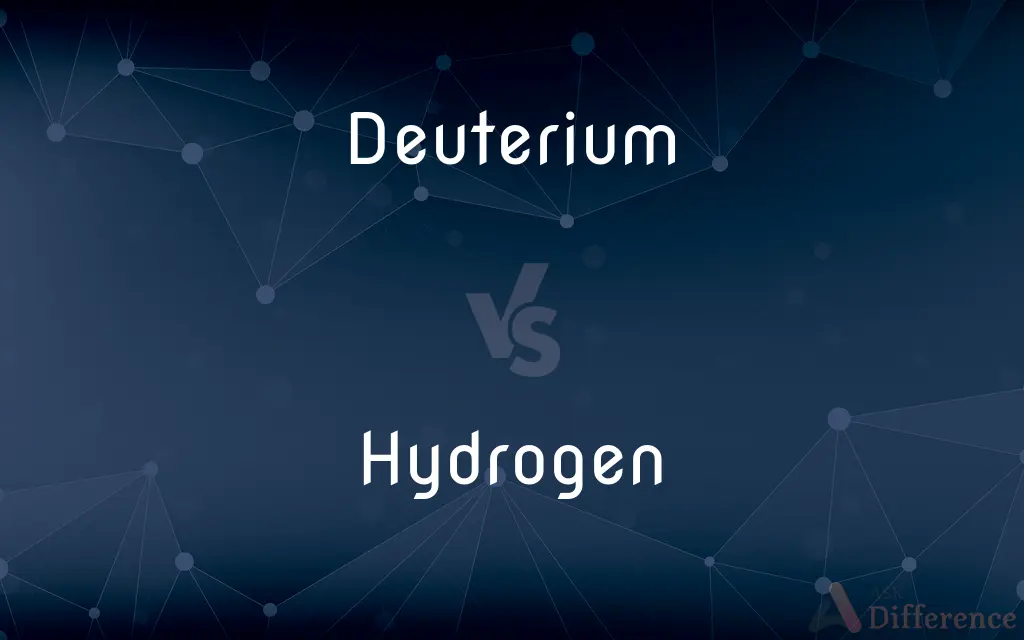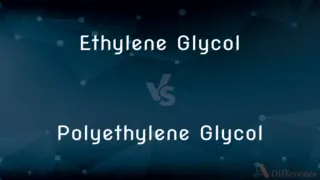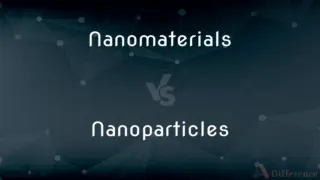Deuterium vs. Hydrogen — What's the Difference?
By Maham Liaqat & Urooj Arif — Updated on April 16, 2024
Hydrogen, the simplest and most abundant element, consists of one proton and one electron; deuterium, its stable isotope, also includes one neutron, altering its nuclear properties but retaining similar chemical behavior.

Difference Between Deuterium and Hydrogen
Table of Contents
ADVERTISEMENT
Key Differences
Hydrogen is the lightest element on the periodic table, commonly found in nature and used extensively in chemical processes and as a potential clean energy source. Deuterium, a heavier isotope of hydrogen, contains an additional neutron, which doubles its atomic mass but does not significantly change its chemical reactivity.
While both isotopes form water when combined with oxygen, water containing hydrogen is more prevalent as "light water," whereas water that includes deuterium is known as "heavy water" due to its increased density. In contrast, heavy water is less common and has specialized uses in nuclear reactors due to its ability to act as a neutron moderator.
In terms of physical properties, hydrogen gas is lighter and therefore more buoyant in the Earth's atmosphere, which has practical implications in areas such as meteorology and aeronautics. On the other hand, deuterium, because of its greater mass, exhibits slightly different physical characteristics, such as a lower diffusion rate in air.
Both isotopes play critical roles in scientific research; hydrogen is pivotal in studies related to fuel cells and fundamental chemistry, whereas deuterium is often used in nuclear fusion experiments and as a tracer in biochemical research.
Comparison Chart
Neutron Count
1
0
ADVERTISEMENT
Atomic Mass
Approximately 2 amu
Approximately 1 amu
Natural Abundance
Rare (about 0.015% of all hydrogen)
Most abundant element in the universe
Chemical Reactivity
Similar, but slightly slower reaction rates
High, forms compounds with most elements
Uses
Nuclear reactors, scientific research, tracers
Fuel, chemical synthesis, reducing agent
Compare with Definitions
Deuterium
A stable hydrogen isotope with one neutron.
Deuterium is used in nuclear fusion experiments.
Hydrogen
The lightest and most abundant chemical element.
Hydrogen is a key component in water and organic compounds.
Deuterium
Forms "heavy water" used in nuclear reactors.
Heavy water moderates neutrons in some nuclear reactors.
Hydrogen
Used as a clean fuel in fuel cells and rockets.
Hydrogen fuel cells power cars and buses with only water as a byproduct.
Deuterium
Slightly slower chemical reactions than hydrogen.
Deuterium bonds are stronger, affecting reaction kinetics.
Hydrogen
Reacts with oxygen to produce water.
Burning hydrogen in air results in water vapor.
Deuterium
Used in scientific research as a tracer.
Deuterium labeling helps track metabolic pathways.
Hydrogen
Essential in various industrial processes like ammonia production.
The Haber process combines nitrogen and hydrogen to form ammonia.
Deuterium
Natural occurrence in ocean water.
Deuterium can be extracted from sea water.
Hydrogen
Exists primarily in molecular form (H2) under normal conditions.
Hydrogen gas is highly flammable.
Deuterium
Deuterium (or hydrogen-2, symbol 2H or D, also known as heavy hydrogen) is one of two stable isotopes of hydrogen (the other being protium, or hydrogen-1). The nucleus of a deuterium atom, called a deuteron, contains one proton and one neutron, whereas the far more common protium has no neutrons in the nucleus.
Hydrogen
Hydrogen is the chemical element with the symbol H and atomic number 1. Hydrogen is the lightest element in the periodic table.
Deuterium
A naturally occurring isotope of hydrogen, H-2, having one proton and one neutron in the nucleus.
Hydrogen
A colorless, highly flammable element, that occurs as a diatomic molecule, H2, the lightest of all gases and the most abundant element in the universe, used in the production of synthetic ammonia and methanol, in petroleum refining, in the hydrogenation of organic materials, as a reducing atmosphere, in oxyhydrogen torches, in cryogenic research, and in rocket fuels. Atomic number 1; atomic weight 1.00794; melting point -259.1°C; boiling point -252.8°C; density at 0°C 0.08988 gram per liter; valence 1. See Periodic Table.
Deuterium
(isotope) An isotope of hydrogen formed of one proton and one neutron in each atom - H.
Heavy water is "heavy" because it contains deuterium.
Hydrogen
The lightest chemical element (symbol H), with an atomic number of 1 and atomic weight of 1.00794. Category:en:Hydrogen
Deuterium
An atom of this isotope.
There were about 80 deuteriums for every million protiums, and virtually no tritium.
Hydrogen
An atom of the element.
Deuterium
An isotope of hydrogen which has one neutron (as opposed to zero neutrons in hydrogen)
Hydrogen
Molecular hydrogen (H2), a colourless, odourless and flammable gas at room temperature.
Hydrogen
A molecule of this molecular species
Hydrogen
A sample of the element/molecule.
Hydrogen
A gaseous element, colorless, tasteless, and odorless, the lightest known substance, being fourteen and a half times lighter than air (hence its use in filling balloons), and over eleven thousand times lighter than water. It is very abundant, being an ingredient of water and of many other substances, especially those of animal or vegetable origin. It may by produced in many ways, but is chiefly obtained by the action of acids (as sulphuric) on metals, as zinc, iron, etc. It is very inflammable, and is an ingredient of coal gas and water gas. It is standard of chemical equivalents or combining weights, and also of valence, being the typical monad. Symbol H. Atomic weight 1.
Hydrogen
A nonmetallic univalent element that is normally a colorless and odorless highly flammable diatomic gas; the simplest and lightest and most abundant element in the universe
Common Curiosities
Can hydrogen be used as a primary energy source?
Yes, hydrogen is considered a potential primary energy source, especially in fuel cells that convert chemical energy directly into electricity.
How is deuterium extracted?
Deuterium is extracted from natural water sources through processes like fractional distillation and electrolysis.
What are the environmental impacts of hydrogen use?
When used in fuel cells, hydrogen produces no emissions other than water vapor, making it environmentally friendly; however, its production from fossil fuels can be carbon-intensive.
Why is deuterium important in nuclear reactors?
Deuterium is used in nuclear reactors because it is an effective moderator of neutrons, allowing sustained nuclear reactions.
Are there stable isotopes of hydrogen other than deuterium?
Besides deuterium, tritium is another hydrogen isotope, but it is radioactive and much less stable.
Why isn't deuterium more widely used in everyday applications?
Due to its rarity and the cost of extraction, deuterium's use is generally limited to specific scientific and industrial applications.
How is hydrogen stored for use as a fuel?
Hydrogen is stored under high pressure as a gas or liquefied at low temperatures to be used as a fuel.
Is heavy water dangerous?
Heavy water is not radioactive or particularly harmful to humans in small amounts, but it can pose health risks if consumed in large quantities instead of normal water.
What are the roles of hydrogen and deuterium in the universe?
Hydrogen is the most abundant element in the universe, crucial for star formation, while deuterium provides insights into cosmological theories and processes.
What are the medical applications of deuterium?
Deuterium is used in pharmaceutical research to study drug metabolism and mechanism of action through labeling.
How do hydrogen and deuterium compare in terms of stability?
Both are stable, but the presence of a neutron makes deuterium slightly less reactive than hydrogen.
Can deuterium be used in regular combustion engines?
Deuterium is not practical for use in traditional combustion engines due to its properties and the specific conditions required for its combustion.
How does the presence of a neutron make deuterium different from hydrogen?
The additional neutron in deuterium increases its atomic mass, affecting its physical properties like boiling and melting points but not altering its chemical properties significantly.
What is the potential for hydrogen in renewable energy?
Hydrogen has significant potential in renewable energy as a storage medium for excess energy produced from wind, solar, and other renewable sources.
How do the boiling points of hydrogen and deuterium compare?
The boiling point of deuterium is slightly higher than that of hydrogen due to the increased intermolecular forces caused by the additional neutron.
Share Your Discovery

Previous Comparison
Factual vs. Nonfactual
Next Comparison
Force vs. StressAuthor Spotlight
Written by
Maham LiaqatCo-written by
Urooj ArifUrooj is a skilled content writer at Ask Difference, known for her exceptional ability to simplify complex topics into engaging and informative content. With a passion for research and a flair for clear, concise writing, she consistently delivers articles that resonate with our diverse audience.














































